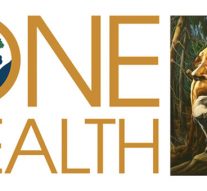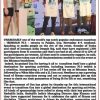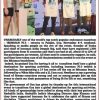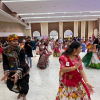Goa is abuzz with excitement as vintage bike and car owners, users, collectors and fans are decking […]

EMBRACING ONE HEALTH Together for a safer, sustainable future
Uncategorized November 7, 2025By Dr Amit Dias
A One Health Day Special!
As the Indian Council of Medical Research (ICMR) and the Indian Association of Preventive & Social Medicine (IAPSM) launch a nationwide movement to create awareness on ONE HEALTH, Dr Amit Dias draws our attention to the crucial threads that bind human, animal, and environmental health. He urges us to end the era of silos and embrace the interconnectedness of all living systems for a healthier planet. “We need to embrace One Health and stand together for a safer and sustainable future,” he says in this thought-provoking article.
What Exactly is One Health?
FOR decades, we worked in silos — doctors treating humans, veterinarians caring for animals, and environmental scientists studying the world around us. But the truth is we share one planet, one ecosystem and one health.
The One Health concept recognizes that the health of people, animals, and the environment are deeply interconnected. If one part suffers, the others inevitably follow.
Emerging infectious diseases, antimicrobial resistance (AMR), and climate change are no longer distant problems — they’re here, affecting the food we eat, the air we breathe, and the health of every living being.
Have We Forgotten COVID-19?
NOT long ago, the world came to a standstill. Streets were empty, airports silent, and fear filled every home. The COVID-19 pandemic reminded us, in the harshest way possible, how fragile our existence can be when we ignore the balance between humans, animals, and nature.
The virus that turned our world upside down did not appear out of thin air. It originated in a live animal market in China, where wild animals and humans were in close contact. This allowed a virus that existed peacefully in animals to jump across species — a process scientists call a “spillover.”
This was not the first warning. We’ve seen it before.
• Bird Flu emerged when poultry farms became hotspots for virus transmission.
• Swine Flu jumped from pigs to humans, spreading across the globe.
• Nipah Virus was traced to bats feeding on partially eaten fruit consumed by humans.
• Ebola outbreaks in Africa have been linked to forest-dwelling bats.
Each time, the pattern is the same: We disturb nature and nature fights back.
The data behind the threat:
THE data consistently underscores that the majority of threats we face originate from the animal-human-environment interface:
• Emerging Infectious Diseases (EIDs): It is estimated that up to 75% of emerging infectious diseases are of zoonotic origin—meaning they jump from animals to humans.
• Known Infectious Diseases: Approximately 60% of known human infectious diseases are estimated to be zoonotic.
• Annual Impact: Zoonoses are responsible for an estimated 2.5 billion cases of human illness and 2.7 million human deaths worldwide each year.
• Wildlife Reservoirs: Of the emerging zoonotic diseases, a significant proportion—often cited as over 71%—have their origins in wildlife, emphasizing the impact of habitat encroachment.
• Antimicrobial Resistance (AMR): The European region alone sees 35,000 deaths annually attributed to AMR, costing countries billions, with significant usage occurring in the animal health sector.
• Environmental Impact: The WHO has noted that one in every four deaths globally can be attributed to environmental factors, directly linking ecosystem health to human health outcomes.
These figures powerfully illustrate why the One Health approach is mandatory. We are not addressing isolated problems; we are tackling a systemic vulnerability where pathogens, driven by environmental change, move seamlessly between species.
The Invisible Web: How We Are All Connected
IT might seem abstract, but these common examples will make the connection clear:
Zoonotic Threats: About 75% of emerging infections—like COVID-19, Nipah, or Monkeypox—originate from animals. When forests are destroyed for development or agriculture, wild species come into closer contact with humans, creating perfect conditions for diseases to spill over.
Vector Menace: Climate change and poor waste management create breeding grounds for mosquitoes, spreading dengue and malaria. What begins as an environmental issue quickly becomes a human health crisis.
Antimicrobial Resistance (AMR): Excessive antibiotic use in humans, livestock, and crops allows resistant bacteria to flourish. These superbugs can spread through soil, water, and food—rendering life-saving drugs ineffective.
Restoring the Balance:
WE’VE disrupted the delicate balance of nature. True human health cannot exist without ecological health. We must shift from reacting to disease outbreaks to proactively preventing them—through better surveillance, environmental protection, and responsible use of antimicrobials.
Building a Safer Future:
PROGRESS has been made since avian influenza and COVID-19, but much remains to be done. We need to institutionalize One Health governance, operationalize cross-sectoral surveillance, and invest sustainably. The One Health Joint Plan of Action (2022–2026) is a step forward, but real success depends on the successful collaboration at every level.
Embracing ONE HEALTH – Time for Action
Here is a simple way to remember the core principles of ONEHEALTH:
O – Observe and respect nature
N – Nurture Intersectoral collaboration
E – Educate and empower communities
H – Harness science and technology for surveillance
E – Environmental degradation should be prevented
A – Antimicrobials to be used responsibly
L – Lead local initiatives with global vision
T – Track and report diseases promptly
H – Help build a healthier, sustainable world
The Way Forward:
THERE is a need for greater awareness. The IAPSM and ICMR launched a nationwide awareness drive on One Health. Awareness programs were held at RHTC Mandur and UHTC St Cruz under the Department of Community Medicine in Goa on One Health Day. On Global One Health Day let’s remind ourselves that our fates are interwoven. A virus in a bat, a microbe in the soil, or a change in the climate can all influence human health. By embracing One Health, we protect not just ourselves, but also the generations to come. United action today will shape a safer, healthier, and more harmonious tomorrow. Together for a safer, sustainable future.
ICMR- IAPSM One Health Awareness Walkathon at UHTC St Cruz on World One Health Day















